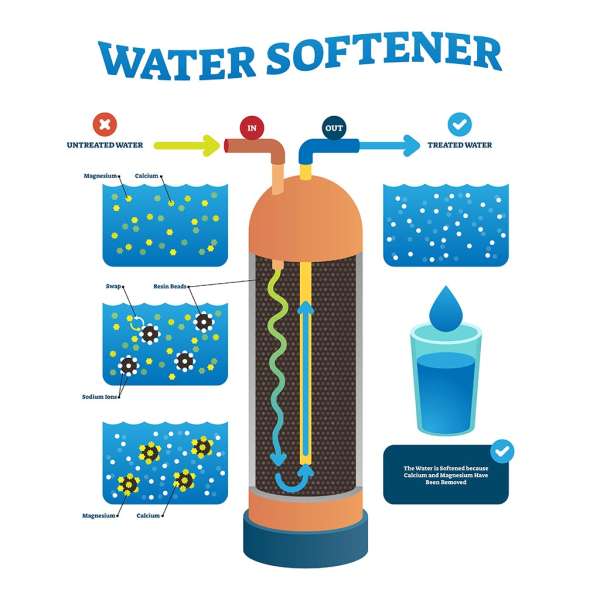
The modern water softener is a system which contains a material called ion exchange resin, to remove hardness minerals from the hard water supply. The removal of the minerals eliminates scale in the hot water system, bathroom and shower fittings, and puts a stop to scum forming when soap is used in sinks, baths and with washing and laundry.
The water softener consists of three basic components:
In modern units the resin tank is usually located inside the brine tank, with the brine tank being the "external cabinet" of the softener. The dimensions of the cabinet may vary, but usually the cabinet can be conveniently installed under the kitchen sink.
The single tank water softener employs one tank of resin and is the most common type of domestic softener. For the resin to be regenerated, the tank needs to be taken out of service and a bypass valve opened. For this reason, while the regeneration takes place (which historically took up to 90 minutes but can be as little as 12 minutes nowadays) only hard water is available, therefore the regeneration usually is programmed to occur during the night.
A lot of water softeners operate on a time control basis. A timer is the simplest form of control and is usually the less expensive option. The timer control calculation includes the number of days that the system will operate, the number of people in the house, the capacity of the softener and the hardness of the water supply - and then the softener is set to regenerate at a certain time of the night at this calculated frequency.
Regardless of the volume of the water used, the system which operates on a time control basis, will regenerate at the pre-set number of days. It is advisable that the water softener is switched off if it is not going to be used for a period of time, such as holidays.
A simple volume-controlled water softener system is designed to adjust to the demand and to avoid over or under regenerating the softener. It will regenerate when the pre-set volume of water used has been achieved. This is fine in theory however on small water softeners it can prove extremely inefficient as the pre-set volume below which it will regenerate can be reached at any time during the day and can represent 30-50% of the softeners total capacity. Given that the pre set volume must be enough to last all day, but might only be reached late in the day. Simple Meter controlled water softener will frequently regenerate and not use all of the capacity available.
Some, more sophisticated control systems are programmed to monitor daily water usage and ensure that regeneration takes place on the best possible night, to make sure that softened water is always available. These systems then adjust the amount of salt used during the regeneration to match the actual amount of water used, thus eliminating the waste of unused capacity. This method of control is ideally suited to small single cylinder water softeners as it ensures the restoration of resin capacity and helps to use salt and water more efficiently.
A two-tank water softener system uses two resin tanks: when one is in service, the other one is on standby. Some systems use both tanks at once but have to partially shut down from time to time to carry out the regeneration. The control system monitors the water flow and switches the flow to the other tank after the first tank is exhausted. It then regenerates the first tank while the second one is working. That ensures that the soft water is available even during regeneration, and system continues to swap from one tank to the other, regenerating when necessary.
The twin tank water softener system regenerates on volume, and the full capacity of the resin is used for each service cycle. This technology has been adapted to small domestic systems however using a very small resin tank limits the available flow and can lead to a high percentage of the total water used being used during the “little and often” regeneration cycles. The waste water being flushed to drain. Also, small twin tank water softeners use a lot of salt in order to keep the capacity between regenerations as high as possible.
Some twin tank brands have a non-electric control head, and use water pressure to operate the valves and measure the flow to monitor the volume of water used. These are most frequently used on small domestic water softeners and suffer the same limitations as all small twin tank softeners with higher waste water volume and limited flow.
There is a wide range of brands from which to choose the most suitable model. Water softeners come in different sizes and cabinet designs. All systems use the proven ion-exchange process, but differ in operational and control technology.
A water softener usually has a 10 to 20 year lifetime, and can be moved from house to house. The best way to choose the right model for you is to schedule a free telephone consultation on 01932 245 200 where our specialists understand your system type and size will present the pros and cons of various models for you and will recommend the most suitable product for your requirements, size of the household and budget.
We do, of course, have to visit your home to survey for installation.